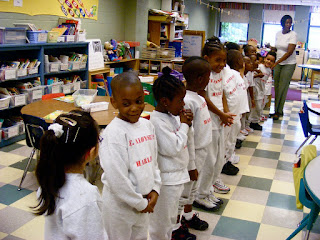After our tour of the school library at St. Aloysius, we visited a kindergarten class who recited the following poem for us:
I, Too, Sing America by Langston Hughes
I, too, sing America.
I am the darker brother.
They send me to eat in the kitchen
When company comes,
But I laugh,
And eat well,
And grow strong.
Tomorrow,
I'll be at the table
When company comes.
Nobody'll dare
Say to me,
"Eat in the kitchen,"
Then.
Besides,
They'll see how beautiful I am
And be ashamed--
I, too, am America.
Reflection on St. Aloysisus elementary by 2010 Program Assistant and former volunteer, Sabrina
Sabrina is a graduate of Mount St. Vincent and is studying mental health counseling at Columbia University Teacher's College.
There is a phrase that goes something along the lines of, “it just keeps getting better and better." This is truly what I can say for Charity in the City program this year. It never ceases to amaze me how many new experiences, along with the challenges, that I have gained since volunteering in this program two years ago. Even though I may be part of the staff this year, it does not limit me in terms of learning how to give to others in this life of charity. Thus, when I was asked what has touched you over the past two weeks, it was difficult at first because a lot of these experiences touched me. However, the one experience that really inspired me the most was our visit to St. Aloyisious’s School in Harlem. Even though we visited the school for about two hours I was left with something that I will never forget and that is pride.
We often define pride as a quality of someone who is boastful. The pride that I speak of is that of is that of being an African-American woman. Sr. Margaret took us to visit one of the kindergarten classes in the school. When we came in the children sang the song they were going to sing for graduation “Welcome to first grade." Then they recited in loud and clear voices "I, Too, Sing America" by Langston Hughes. Nothing has touched me more than hearing these kids recite this poem. It brought such joy to my heart that I was actually moved to tears. These children may be too young to understand what this poem means, but for the people who lived during the Civil Rights Movement, the poem signifies a dream that many fought and sacrificed their lives to see fulfilled. Many fought for this dream so that all of us in this world could have the opportunity to interact with other cultures both academically and socially without the rules of segregation.
It saddens me to know that many children in today’s society are not receiving the proper education in the classrooms due to budget cuts, increasing rates of teacher unemployment, etc. Too often I have seen children out of school because of these factors, and also hanging out with the wrong crowd. Thus, many students will not receive the history of those who came before them and never understand why they are so important to us.
Later on that morning, I was blown away by the play put on by the second graders called “I Can Soar Too,” in which every student portrayed characters from Black history such as Martin Luther King, Hattie, Carver, Owens, Obama, etc. It was absolutely amazing to see from a different perspective how each individual in history is constantly climbing on the shoulders of those before, and it is because of those that came before that this new generation can fly. St. Aloysius School has provided a multicultural curriculum to the students in this school and I felt so proud that these children have such a wonderful opportunity to learn about their history. I felt such extreme joy and pride to be an African-American woman. To know how far we have come and how much more we have to go is a blessing, and instilling these values of freedom in the younger generation starts with us.


















